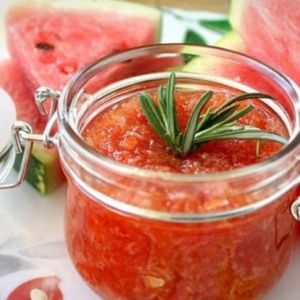Late watermelon “Kholodok”: why farmers love it and how to grow it correctly
Watermelon is 92% water, rich in vitamins A and E, and refreshing on the hottest day. The birthplace of watermelons is South Africa. In Russia, they are grown mainly in the south: melons love warmth, sun, moderate climate and warm rains. Among the variety of varieties, summer residents highlight the Kholodok watermelon, which was bred by Russian agronomists.
Let us consider in detail the cultivation technology and the characteristics of the variety.
Description of the watermelon variety
The variety is medium late, ripens in 85–95 days from planting. It is unpretentious in care, grown by seedlings or seeds in open ground.
Distinctive features
 The bushes are powerful, spreading. The lashes reach 4-5 m in length. The leaves are dark green and drooping.
The bushes are powerful, spreading. The lashes reach 4-5 m in length. The leaves are dark green and drooping.
The bushes show stable productivity both in the greenhouse and in the open air.
Composition, properties, calorie content
There are only 25 kcal per 100 g of red pulp. The fruits contain dietary fiber that activates metabolism. Watermelon juice contains fructose, which is absorbed many times faster than sugar.
Watermelon fruits, a popular diuretic folk remedy, relieve swelling and remove excess fluid from the body. Watermelons are a source of microelements. They contain calcium, phosphorus, magnesium, iron, zinc.
Important! People with diabetes or kidney stones should not consume a lot of pulp.
Fruit characteristics and yield
 Up to 4–7 large, heavy fruits will ripen on one bush at the same time. Watermelon weight: from 4 to 6 kg.
Up to 4–7 large, heavy fruits will ripen on one bush at the same time. Watermelon weight: from 4 to 6 kg.
The peel is slightly segmented, light green.The shape is spherical, the pulp is sugary and sweet, bright red in color.
Seeds of watermelon
The seeds are large and heavy, reaching 2 cm in length. They consist of 35% protein and contain amino acids and B vitamins. The shell is dense, rough, and brown in color.
How to grow a variety yourself
It is recommended to plant Chill by seedling method. Seedlings are prepared in mid or late March.
Growing seedlings
For this, prepare a convenient and environmentally friendly container. Suitable for the Kholodok variety: a plastic container with a tray. It is easy to use, inexpensive, and has drainage holes. Purchase a container from a gardening store. They also buy ready-made soil for seedlings. Such land has already been disinfected and saturated with vitamins for the development of culture. It is recommended to purchase “Universal”, “Garden” or “Strong” soil.
The next stage is preparing the seeds. They are disinfected using the drug “Fitosporin M”, Bordeaux mixture or a weak solution of potassium permanganate. The seeds are soaked for a day and wrapped in damp gauze for several days. Only after these procedures will the material be ready for planting.
Pour soil into the container and make grooves at a distance of 30 cm from each other. The depth of the hole is about 5 cm. A seed is placed in each hole, covered with a layer of soil on top, gently slamming it down. The seedlings are stored in a warm place, watered once every 4 days, and fertilized with liquid droppings or mullein. Chill is planted in the beds in mid-May.
Planting in the garden
The soil in the beds should be light and loose. The ground is carefully dug up and cleared of weeds and debris. Watermelon planting pattern - 70x150. Make holes in the ground 10 cm deep and pour water into them.Seedlings are moved into each, the base of the stem is sprinkled with earth and straw to retain moisture. When growing in a greenhouse, the structure is ventilated, the walls are wiped with a solution of potassium permanganate.
Important! The predecessors of watermelon are cabbage, carrots, potatoes, greens, and onions. Do not plant Chill after pumpkins and melons.
Variety care
The cold does not like excess moisture, so the beds are watered as they dry out. About 1.5 liters of water are spent on one bush, directing the stream directly to the root and not to the leaves. If the summer is rainy, then the amount of watering is reduced. Moisten the watermelon early in the morning or in the evening, after sunset. Otherwise, the water will quickly evaporate and sunburn will appear on the bushes.
A month after planting, the main stem of the plant is formed. The side shoots are removed, leaving only 3-4 lashes. Long lashes are unraveled and sprinkled with earth in several places so that the wind does not break them.
Watermelon is fed with organic and mineral substances. They improve the taste and appearance of fruits, accelerate development, and protect against diseases and pests.
The following substances are used:
- humus;
- manure;
- sourdough bread;
- eggshells;
- "Nutriflex";
- "Master";
- "Gringo".
Interesting! Seaweed is used to feed melons. They are rich in potassium and decompose quickly.
Features of cultivation and possible difficulties
Gardeners often face the problem of excess fertilizer. To ensure a balanced and healthy diet, feed Chill once every 2 weeks, alternating organic matter and minerals. It is not recommended to apply nitrogen and potassium at the same time: this will lead to an increase in green mass, and not to the development of fruits. Before fertilizing, the beds are watered to prevent the plant from getting chemical burns.
As soon as the fruits become the size of an apple, the bush is pinched. Watermelons are tied to a support, which is why the crop does not come into contact with the ground and does not rot. Wooden pegs or trellises, as well as stockings, old T-shirts and other scraps of fabric are suitable for garters. If you do not tie up the bush in time, the stems will break under the weight of heavy fruits and they will end up on the ground.
Diseases and pests
Despite its immunity and cold resistance, if it is not cared for properly, Chill gets sick. Anthracnose, a fungal disease, is found in garden beds. Occurs due to excess moisture and improper care. A brown pattern appears on the leaves and stems, and the fruits lose their shape and taste. Anthracnose is treated with Ordan or Acrobat. For prevention, bushes are sprayed with iodine.
Another disease, ascochyta blight, is a frequent visitor to greenhouses and greenhouses. The stems become soft and brittle, the bushes die. Occurs due to stuffiness and humidity. As a preventative measure, regularly ventilate the structure and follow the planting pattern. A fungal disease is treated with the drug “HOM” or a solution of copper sulfate.
Among the pests, melon aphids are noted. The insect appears on leaves and feeds on plant sap. If it is not detected in time, the bushes will begin to shed flowers and lose leaves. An ash solution helps fight aphids: take 200 g of ash and 50 g of laundry soap per 10 liters of water. The mixture is sprayed onto watermelons from a spray bottle.
Harvesting and application
 Collect Chill in September, when the peel becomes shiny and the stalk dries out. A ripe watermelon is hard and produces a dull sound when tapped.
Collect Chill in September, when the peel becomes shiny and the stalk dries out. A ripe watermelon is hard and produces a dull sound when tapped.
Store the harvest in a cold, dark basement or cellar. Air humidity should be at least 75%.If these conditions are met, the Chill will last until winter without losing its taste.
Watermelon makes delicious fruit baskets, salads, and refreshing snacks. The fruits are combined with strawberries, melon, mint. Smoothies, cocktails, jelly, and jam are prepared from them. Watermelon is also used for winter preparations: pickled watermelons tasty and healthy.
Interesting! In Vietnam, it is customary to serve watermelon during New Year celebrations. The color red symbolizes good luck. Fruit seeds eaten as a snack.
Advantages and disadvantages of the variety
Summer residents love Kholodok for its ease of care and versatility in use. In addition, the variety has the following advantages:
- sweet, sugary and juicy pulp;
- large seeds;
- good keeping quality, transportability;
- long shelf life.
However, it will be possible to get a rich harvest only in the southern regions. In the north, Chill will not have time to mature during the short and cool summer.
Reviews
 Gardeners share with each other not only the secrets of growing, but also their opinions about the variety:
Gardeners share with each other not only the secrets of growing, but also their opinions about the variety:
Olga, Voronezh: «I am planting watermelon Chill for the third season in a row. I use the seedling method and have been preparing seedlings since March. The variety does not cause any trouble in caring for, the harvest is always rich. We collect 5 large watermelons from a bush.”
Sergey, Moscow region: “I first chose the Kholodok variety 5 years ago. I plant it in the greenhouse. I buy seeds at the market, soak them in boric acid at home and only then use them. The variety has excellent taste: sweet and juicy. We eat the entire harvest in a week.”
Galina, Krasnodar: “The chill did not take root in my area. I don’t know what’s wrong, maybe it’s the acidic soil. The harvest was late, the fruit set slowly, and the taste was unsweetened.”
Conclusion
The ripening of the Kholodok variety takes 90 days.The crop is planted on loose, well-warmed soils. To protect against the cold, film shelters are built, which are removed after 10–15 days. Care consists of timely watering, fertilizing and bush formation. The color of the fruit and the dry stem will help determine the ripeness of a watermelon.
The cut should be bright red and the flesh should be juicy. Delicious fruits are added to compotes, smoothies, jams, salads and autumn preparations.